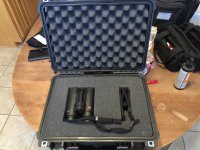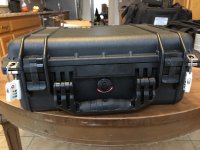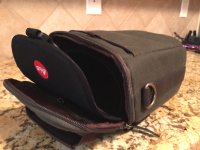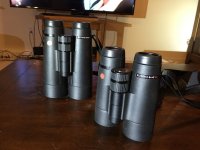dwever
Well-known member
In April I'll be traveling to Rwanda with Lecia Ultravid HD Plus 10x50, and the same series 8x42, as well as a regular Ultravid 8x20. I'll buy a new Pelican Case foam insert so I can customize it for multiple bins.
1. If you can, carry the binoculars on board with you. Use a thick extra protective sleeve around your thin why-didn't-they-build-it-better factory supplied Leica case (picture 3). If you need to, use a Pelican Case similar to the one pictured as one of your carry on bags particularly if you're packing multiple pairs of binoculars. The Pelican 1450 pictured is well under the carry-on maximum size restrictions, only cost ca. $100; and if you need more room there are other carry-on compliant Pelicans with wheels and space for laptops, other articles, and a couple of 8x42 - 10x50 bins (such as a Pelican 1510 LFC for around $250). As the comments below attest, the best option is to have your bins with you in the cabin. Also, when at home, the 1450 in the single binocular configuration pictured makes a perfect residence for my bins in the trunk of my car - I'm never thinking about getting them from the house to the car.
Based on the comments below, doesn't seem like many people have to airline check their bins. If you do need to airline check your binoculars as I do:
2. The Pelican Case pictured is a model 1450. Use locks - that are TSA approved, TSA has a tool to open them as do other airport security internationally, but should keep curious baggage workers out. If they are stolen, the baggage insurer (such as Delta) is not going to come back on you that you didn't take reasonable caution as long as those lock were on. They particularly want to point that out when you are traveling where non-Delta employees are handling your luggage (this is true for most air lines I guess). Over the years we have had some nightmare failures to take responsibility by airlines overseas, particularly when traveling on the Continent of Africa. When more than one airline is involved they tend to point at each other rather than fix the issue even when who the responsible party is clear. Try to stay with one airline, or at least partner airlines such as Delta and KLM.
3. Purchase baggage insurance! For example Delta generally charges you 1% of declared excess value on international flights. So I'll pay $50 for $5,000 in coverage for a Pelican Case packing the two alpha bins.
4. Take pictures of how protected the packing was. If there is damage, leave no doubt that it was not because you didn't have them protected adequately. Have your serial numbers on your smart phone. Have the details of how much pressure your case can take. Get the "Protector Series" of Pelican Cases. They can withstand hundreds of pounds.
5. Buy a thicker protective case fitted outer sleeve for your Leica binocular supplied case (Picture 3). You will be thankful for that when the stewardess tells you to place them under the seat in front of you or the over-head bin, and there's some peace of mind. Not much extra bulk and way WAY more protection when you're not using the comparatively huge pelican. The green aftermarket case pictured perfectly fits in height and circumference the Leica 8x42 case and is sold at Best Buy.
6. Once you arrive in country, plan on having you pair in your back pack at all times with your laptop. Unless you are in a five-star hotel you KNOW has virtually no risk and will take responsibility if something does come up missing, just keep it with you, nice reason for Leica's compactness. In some countries leaving it locked in your trunk means virtually nothing. I was in Kigali last year and my buddy had all of his professional video, still, computer, and iPad smashed and grabbed in an armed physically guarded parking lot in an instant. The incident was recorded by the high-end restaurant's security video, but that video later came up "missing" during the police investigation after which the restaurant lost all interest in any accountability for the theft.
7. Fine dust. Some areas of the world, like many parts of Africa, have a super-fine red dust that gets in to everything. The dust's penetration is absolutely remarkable into regular luggage. Whilst your alpha bins are water-proof, it is much better to wipe a coating of that dust off the exterior of your Pelican Case rather than off the exterior of your $2,400 binoculars. If I'm not carrying the Pelican Case somewhere, I'll put the binoculars in a zip-lock freezer bag. And you still going to end up hosing them off at some point.
In the UK at Heathrow I left a MacBook Pro in an airline seat back. I called back to the airline from Nairobi, they went on the plane, stored it at the airport, and had it waiting for me when I came back through on the return leg. So it's not always a sad ending.
1. If you can, carry the binoculars on board with you. Use a thick extra protective sleeve around your thin why-didn't-they-build-it-better factory supplied Leica case (picture 3). If you need to, use a Pelican Case similar to the one pictured as one of your carry on bags particularly if you're packing multiple pairs of binoculars. The Pelican 1450 pictured is well under the carry-on maximum size restrictions, only cost ca. $100; and if you need more room there are other carry-on compliant Pelicans with wheels and space for laptops, other articles, and a couple of 8x42 - 10x50 bins (such as a Pelican 1510 LFC for around $250). As the comments below attest, the best option is to have your bins with you in the cabin. Also, when at home, the 1450 in the single binocular configuration pictured makes a perfect residence for my bins in the trunk of my car - I'm never thinking about getting them from the house to the car.
Based on the comments below, doesn't seem like many people have to airline check their bins. If you do need to airline check your binoculars as I do:
2. The Pelican Case pictured is a model 1450. Use locks - that are TSA approved, TSA has a tool to open them as do other airport security internationally, but should keep curious baggage workers out. If they are stolen, the baggage insurer (such as Delta) is not going to come back on you that you didn't take reasonable caution as long as those lock were on. They particularly want to point that out when you are traveling where non-Delta employees are handling your luggage (this is true for most air lines I guess). Over the years we have had some nightmare failures to take responsibility by airlines overseas, particularly when traveling on the Continent of Africa. When more than one airline is involved they tend to point at each other rather than fix the issue even when who the responsible party is clear. Try to stay with one airline, or at least partner airlines such as Delta and KLM.
3. Purchase baggage insurance! For example Delta generally charges you 1% of declared excess value on international flights. So I'll pay $50 for $5,000 in coverage for a Pelican Case packing the two alpha bins.
4. Take pictures of how protected the packing was. If there is damage, leave no doubt that it was not because you didn't have them protected adequately. Have your serial numbers on your smart phone. Have the details of how much pressure your case can take. Get the "Protector Series" of Pelican Cases. They can withstand hundreds of pounds.
5. Buy a thicker protective case fitted outer sleeve for your Leica binocular supplied case (Picture 3). You will be thankful for that when the stewardess tells you to place them under the seat in front of you or the over-head bin, and there's some peace of mind. Not much extra bulk and way WAY more protection when you're not using the comparatively huge pelican. The green aftermarket case pictured perfectly fits in height and circumference the Leica 8x42 case and is sold at Best Buy.
6. Once you arrive in country, plan on having you pair in your back pack at all times with your laptop. Unless you are in a five-star hotel you KNOW has virtually no risk and will take responsibility if something does come up missing, just keep it with you, nice reason for Leica's compactness. In some countries leaving it locked in your trunk means virtually nothing. I was in Kigali last year and my buddy had all of his professional video, still, computer, and iPad smashed and grabbed in an armed physically guarded parking lot in an instant. The incident was recorded by the high-end restaurant's security video, but that video later came up "missing" during the police investigation after which the restaurant lost all interest in any accountability for the theft.
7. Fine dust. Some areas of the world, like many parts of Africa, have a super-fine red dust that gets in to everything. The dust's penetration is absolutely remarkable into regular luggage. Whilst your alpha bins are water-proof, it is much better to wipe a coating of that dust off the exterior of your Pelican Case rather than off the exterior of your $2,400 binoculars. If I'm not carrying the Pelican Case somewhere, I'll put the binoculars in a zip-lock freezer bag. And you still going to end up hosing them off at some point.
In the UK at Heathrow I left a MacBook Pro in an airline seat back. I called back to the airline from Nairobi, they went on the plane, stored it at the airport, and had it waiting for me when I came back through on the return leg. So it's not always a sad ending.
Attachments
Last edited:









